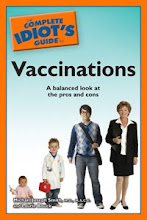Is swine flu the next influenza pandemic? Swine flu does share genetic material with the flu strain that caused the influenza outbreak of 1918-1919, a strain that has been circulating on and off since then. Older adults are more likely to have encountered a version of this flu strain when they were younger, giving them better protection against it now. This topic is familiar to me because I was researching swine flu earlier this year as part of a book about vaccinations that I'm working on with a pediatric epidemiologist.
The 1918-1919 pandemic, the most famous influenza pandemic, infected about 30% of Americans. About 2% of the cases were fatal in an age without antiviral drugs and other medical interventions. Even then-president Woodrow Wilson caught the flu during the pandemic (and survived). Ultimately, influenza killed about 675,000 Americans between 1918 and 1919, an unlikely scenario in the U.S. today with improved medical care and a much better understanding of how infectious diseases spread.
The 1918-1919 flu pandemic was different from the seasonal flu because it spread extremely rapidly, and young adults, rather than the elderly, were most likely to die from the virus. The first U.S. cases in the pandemic were reported among soldiers on a military base in Kansas in 1918, arguably the healthiest members of society, although living in close quarters makes them more susceptible to infectious diseases.
The swine flu that began this month in Mexico is also most deadly among young adults, with numerous sad stories circulating about flu-related deaths in young adults in Mexico and the death of a child in the United States. Swine flu, an illness that pigs get, is sometimes transmitted from pigs to humans (i.e. only those who have been physically near pigs catch the virus). Rarely, swine flu has been transmitted from humans to humans. It has cropped up a few times in the past, most notably in 1976, when about 200 soldiers in Fort Dix, New Jersey were infected, four developed pneumonia, and one died. At Fort Dix, there was no evidence that the soldiers had had contact with pigs. The virus had mutated and was now transmitted from person to person.
Periodically, influenza viruses mutate into something new and more serious, with a potential to spread worldwide (causing a pandemic). For this reason, the 1976 swine flu cases spurred a strong response. A vaccine was developed and a mass swine flu vaccination campaign began that year. About 45 million people were vaccinated against the disease in 1976. The swine flu vaccine used then, however, was later recalled because it appeared to slightly increase the risk of developing a rare neurological problem called Guillain-Barre Syndrome (GBS) which can cause temporary paralysis. Swine flu did not spread and become a pandemic as feared.
For a long time, epidemiologists have been concerned about the source of the next influenza pandemic, often targeting avian influenza ("bird flu"). The swine flu virus circulating today, a mixture of pig, bird, and human viruses, is not a pandemic but it has the potential to become a problem. If you take precautions such as washing your hands adequately and often, however, you can help protect yourself and others.
The seasonal flu (influenza) itself causes plenty of problems every year. The CDC recommends a yearly flu vaccination for children up to age 18 (in part because they often pass on flu to the adults around them), adults 50 and over, and certain other groups of people such as health care providers. (This season's flu vaccination does not protect against swine flu.) Although most people recover easily from the seasonal flu, very young children and the elderly are far more likely to suffer from complications such as pneumonia if they catch it. Many people do not get their recommended flu shot each year. As a result, seasonal influenza is the top cause of vaccine-preventable deaths in United States, killing 36,000 and hospitalizing 226,000 each year, according to the CDC.
You can learn more about swine flu and how to avoid it at the CDC's Swine Influenza and You web page.
You can get updates on what's happening with the swine flu at the CDC Emergency Twitter site.
Subscribe to:
Post Comments (Atom)




No comments:
Post a Comment